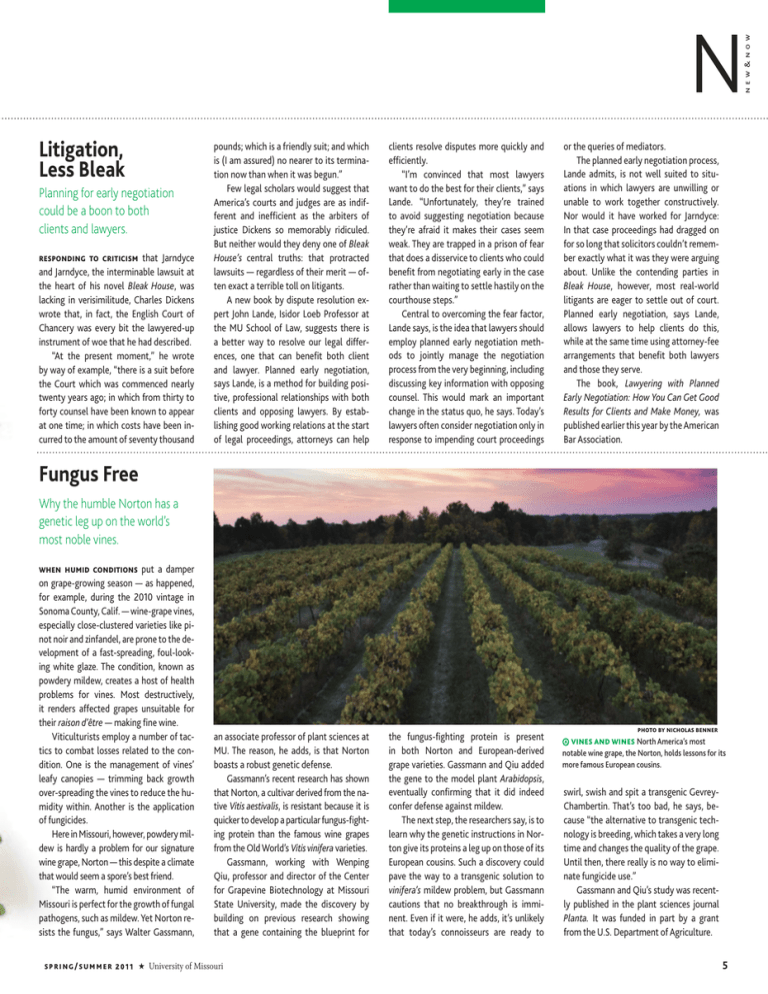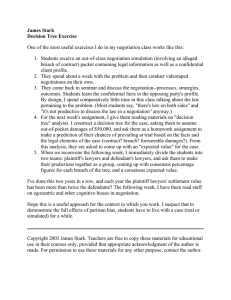Litigation, Fungus Free Why the humble Norton has a
advertisement

new&now Litigation, Less Bleak Planning for early negotiation could be a boon to both clients and lawyers. responding to criticism that Jarndyce and Jarndyce, the interminable lawsuit at the heart of his novel Bleak House, was lacking in verisimilitude, Charles Dickens wrote that, in fact, the English Court of Chancery was every bit the lawyered-up instrument of woe that he had described. “At the present moment,” he wrote by way of example, “there is a suit before the Court which was commenced nearly twenty years ago; in which from thirty to forty counsel have been known to appear at one time; in which costs have been incurred to the amount of seventy thousand pounds; which is a friendly suit; and which is (I am assured) no nearer to its termination now than when it was begun.” Few legal scholars would suggest that America’s courts and judges are as indifferent and inefficient as the arbiters of justice Dickens so memorably ridiculed. But neither would they deny one of Bleak House’s central truths: that protracted lawsuits — regardless of their merit — often exact a terrible toll on litigants. A new book by dispute resolution expert John Lande, Isidor Loeb Professor at the MU School of Law, suggests there is a better way to resolve our legal differences, one that can benefit both client and lawyer. Planned early negotiation, says Lande, is a method for building positive, professional relationships with both clients and opposing lawyers. By establishing good working relations at the start of legal proceedings, attorneys can help clients resolve disputes more quickly and efficiently. “I’m convinced that most lawyers want to do the best for their clients,” says Lande. “Unfortunately, they’re trained to avoid suggesting negotiation because they’re afraid it makes their cases seem weak. They are trapped in a prison of fear that does a disservice to clients who could benefit from negotiating early in the case rather than waiting to settle hastily on the courthouse steps.” Central to overcoming the fear factor, Lande says, is the idea that lawyers should employ planned early negotiation methods to jointly manage the negotiation process from the very beginning, including discussing key information with opposing counsel. This would mark an important change in the status quo, he says. Today’s lawyers often consider negotiation only in response to impending court proceedings an associate professor of plant sciences at MU. The reason, he adds, is that Norton boasts a robust genetic defense. Gassmann’s recent research has shown that Norton, a cultivar derived from the native Vitis aestivalis, is resistant because it is quicker to develop a particular fungus-fighting protein than the famous wine grapes from the Old World’s Vitis vinifera varieties. Gassmann, working with Wenping Qiu, professor and director of the Center for Grapevine Biotechnology at Missouri State University, made the discovery by building on previous research showing that a gene containing the blueprint for the fungus-fighting protein is present in both Norton and European-derived grape varieties. Gassmann and Qiu added the gene to the model plant Arabidopsis, eventually confirming that it did indeed confer defense against mildew. The next step, the researchers say, is to learn why the genetic instructions in Norton give its proteins a leg up on those of its European cousins. Such a discovery could pave the way to a transgenic solution to vinifera’s mildew problem, but Gassmann cautions that no breakthrough is imminent. Even if it were, he adds, it’s unlikely that today’s connoisseurs are ready to or the queries of mediators. The planned early negotiation process, Lande admits, is not well suited to situations in which lawyers are unwilling or unable to work together constructively. Nor would it have worked for Jarndyce: In that case proceedings had dragged on for so long that solicitors couldn’t remember exactly what it was they were arguing about. Unlike the contending parties in Bleak House, however, most real-world litigants are eager to settle out of court. Planned early negotiation, says Lande, allows lawyers to help clients do this, while at the same time using attorney-fee arrangements that benefit both lawyers and those they serve. The book, Lawyering with Planned Early Negotiation: How You Can Get Good Results for Clients and Make Money, was published earlier this year by the American Bar Association. Fungus Free Why the humble Norton has a genetic leg up on the world’s most noble vines. when humid conditions put a damper on grape-growing season — as happened, for example, during the 2010 vintage in Sonoma County, Calif. — wine-grape vines, especially close-clustered varieties like pinot noir and zinfandel, are prone to the development of a fast-spreading, foul-looking white glaze. The condition, known as powdery mildew, creates a host of health problems for vines. Most destructively, it renders affected grapes unsuitable for their raison d’être — making fine wine. Viticulturists employ a number of tactics to combat losses related to the condition. One is the management of vines’ leafy canopies — trimming back growth over-spreading the vines to reduce the humidity within. Another is the application of fungicides. Here in Missouri, however, powdery mildew is hardly a problem for our signature wine grape, Norton — this despite a climate that would seem a spore’s best friend. “The warm, humid environment of Missouri is perfect for the growth of fungal pathogens, such as mildew. Yet Norton resists the fungus,” says Walter Gassmann, s pring/su m m er 2011 H University of Missouri photo by nicholas benner vines and wines North America’s most notable wine grape, the Norton, holds lessons for its more famous European cousins. swirl, swish and spit a transgenic GevreyChambertin. That’s too bad, he says, because “the alternative to transgenic technology is breeding, which takes a very long time and changes the quality of the grape. Until then, there really is no way to eliminate fungicide use.” Gassmann and Qiu’s study was recently published in the plant sciences journal Planta. It was funded in part by a grant from the U.S. Department of Agriculture. 5


